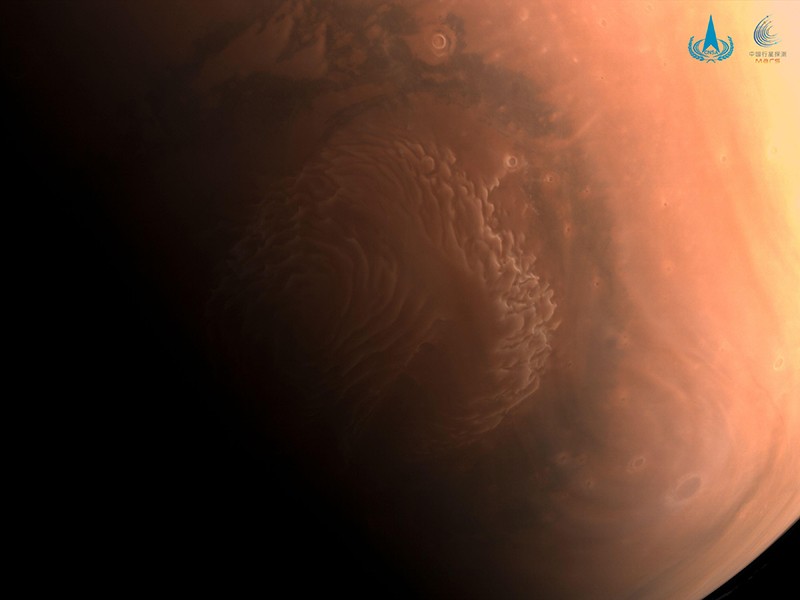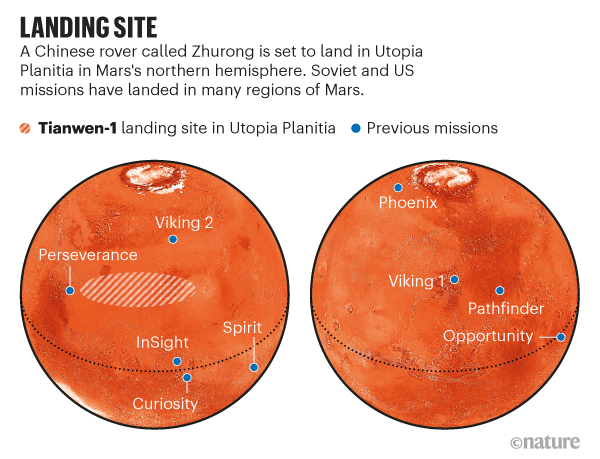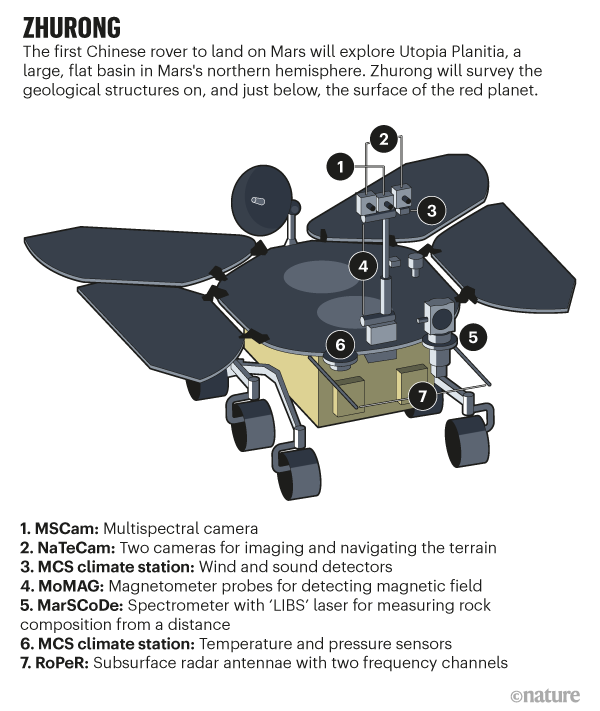The surface of Mars, photographed by China's Tianwen-1 probe after it arrived in orbit in February.Credit: CNSA The attempted landing of...
 |
| The surface of Mars, photographed by China's Tianwen-1 probe after it arrived in orbit in February.Credit: CNSA |
The China National Space Administration (CNSA) is remaining tight-lipped about exactly when its rover, named Zhurong — after a Chinese mythological god of fire — will touch down. If it succeeds, it will join several other active missions at Mars. NASA’s Perseverance rover, which arrived on 18 February, is several hundred kilometres away from the possible landing site, while NASA’s Curiosity rover has been poking around the planet since 2012. Several spacecraft are also circling Mars, including the United Arab Emirates’ Hope orbiter, which also arrived in February. “The more the merrier on Mars,” says David Flannery, an astrobiologist at the Queensland University of Technology in Brisbane, Australia.
Researchers say that the engineering feat of getting there has taken precedence over science in China’s first tour of Mars, but the mission could still reveal new geological information. They are especially excited about the possible detection of permafrost in Utopia Planitia, the region in the northern hemisphere of Mars where Zhurong will land (see 'Landing site').
Biggest test yet
Tianwen-1 includes an orbiter, a lander and a rover — making it the first mission to send all three elements to the planet. The spacecraft departed Earth in July 2020 and arrived at Mars in February 2021, but the landing will be the biggest test yet of China’s nascent deep-space exploration capabilities. The rover could arrive within days, but the CNSA has revealed few details. And scientists in China involved with the mission did not respond to Nature’s requests for interviews before the landing; other researchers say the reason for this is likely to be the high risk of failure.
Landing on Mars is notoriously difficult, not least because engineers back on Earth have no control over it in real time, and must leave pre-programmed instructions to play out. Many missions have been lost, or have crashed on arrival.
In 1997, NASA’s Mars Pathfinder sent its first rover, named Sojourner, to a rocky region of the planet. “We didn’t get a lot of amazing science from that mission, but it paved the way for much more capable autonomous rovers, and now we are reaping the benefits of those missions,” says Flannery, who is working on Perseverance, NASA’s fifth Mars rover.
What to expect
On landing day, the orbiter will release the lander and rover, which will hurtle towards the surface, protected by a heat shield. As the probe closes in on Mars, it will release a parachute to slow its progress, and then use rocket boosters to brake and hover above the ground while a laser-guided system assesses the area for obstacles such as boulders before landing.
A few days later, the six-wheeled solar-powered rover will trundle off the lander to explore for at least three months — but it could survive for years, as NASA’s Spirit and Opportunity rovers did. Utopia Planitia, the designated landing area, is a wide, flat expanse in a vast, feature-less basin that formed when a smaller object smashed into Mars some billions of years ago.
The basin’s surface is mostly covered in volcanic material, which could have been modified by more-recent processes, such as the repeated freezing and thawing of ice. Orosei says that studies of the region from Mars’s orbit suggest that a layer of permafrost could be hiding just below the surface.
In 1975, NASA’s Viking 2 mission also landed on Utopia Planitia, but further north of where Zhurong is scheduled to touch down. “It’s a good place to try a first landing,” explains Flannery. The low altitude, clear terrain and potential for finding ice in the subsurface also means that future missions might be able to collect samples there, and that the region could make a good landing site for crewed missions, he says.
To the west of Zhurong’s landing region, Perseverance is prowling Jezero Crater, and could even get a glimpse of the new visitor if it lands within 200 kilometres and at night, says Flannery.
Measuring Mars
Zhurong is kitted with six instruments for exploring the Martian environment (see 'Zhurong’). Two cameras are fitted on a mast to take images of nearby rocks while stationary, which will be used to plan the journeys it takes. A multispectral camera placed between these two navigation imagers will reveal the minerals present in these rocks.
Like Perseverance, Zhurong has ground-penetrating radar. As it winds its way across the basin, this will reveal geological processes that led to the formation of the regions it travels through. With luck, Zhurong might detect the thin horizon that marks any permafrost, says Orosei. Knowing how deep this lies and its general characteristics could offer insights into more recent climate changes on Mars, and reveal the fate of ancient water that could have once soaked the surface, he says.
If the team is really fortunate, they might even find some very ancient rocks, which might offer a window into Earth’s own history, where most similar evidence has been destroyed by plate tectonics, says Joseph Michalski, a planetary scientist at The University of Hong Kong.
Zhurong’s spectrometer includes a laser-based technology that can zap rocks to study their makeup. It will also be the first rover equipped with a magnetometer to measure the magnetic field in its vicinity. The instrument could provide insights into how Mars lost its strong magnetic field, an event that transformed the planet into a cold, dry place, uninviting to life.
Orbital insights
From orbit, Tianwen-1 will communicate Zhurong’s insights to Earth. But the orbiter will also make its own scientific contributions with its seven instruments, including cameras, ground-penetrating radar, and a spectrometer. A magnetometer and particle analyzers will study the boundary between the higher Martian atmosphere and solar winds to better understand how its magnetic field operates today.
Combined with data from other orbiters studying the planet’s upper atmosphere, it will offer researchers, “a much better picture of what goes on around Mars,” says Orosei. A successful Mars landing could usher in more advanced Chinese missions, including a planned sample return by 2030.

.webp)





